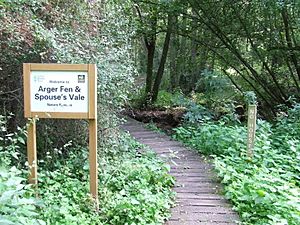Arger Fen facts for kids
| Site of Special Scientific Interest | |
 |
|
| Area of Search | Suffolk |
|---|---|
| Coordinates | 51°59′10″N 0°49′05″E / 51.986°N 0.818°E |
| Interest | Biological |
| Area | 49.7 hectares (0.50 km2; 0.19 sq mi) |
| Notification | 1986 |
| Location map | Magic Map |
Arger Fen is a special natural area in Suffolk, England. It covers about 49.7 hectares, which is like 123 acres. This area is officially called a Site of Special Scientific Interest (SSSI). This means it's a very important place for plants, animals, and geological features.
Arger Fen is made up of two separate parts. One part is the Arger Fen Local Nature Reserve, which is about 17.6 hectares. It also includes parts of the Tiger Hill Local Nature Reserve and the Arger Fen and Spouse's Vale nature reserve. The Suffolk Wildlife Trust helps manage these areas. Arger Fen is also located within the beautiful Dedham Vale Area of Outstanding Natural Beauty.
Contents
Discover Arger Fen
Arger Fen is a mix of different natural places. You can find both woodlands and open meadows here. Many of the trees in the woodlands are very old. Some people believe they have been growing for hundreds of years.
What Makes Arger Fen Special?
The ground at Arger Fen is a mix of different types of soil. Some areas have sand and gravel, while others have clay. This creates many different habitats for plants and animals. For example, you can find wet, marshy areas called "fen" habitats in the lower parts. On the hilltops, there are dry grasslands with acidic soil.
Arger Fen is also special because it's one of only two places in Eastern England where you can find wild cherry trees. These trees are called Prunus avium.
Amazing Wildlife at Arger Fen
This natural reserve is home to many interesting animals. You might spot badgers living in their underground homes called setts. Other rare animals that live here include the hazel dormouse and the barbastelle bat.
In 2012, scientists found that some of the ash trees at Arger Fen were getting sick. These trees were very old, some over 300 years old! The sickness is called ash dieback. In 2013, Arger Fen became a research site. Scientists from the Forestry Commission are studying the trees here. They want to find out if some ash trees can naturally fight off the disease.
Visiting Arger Fen
If you want to visit Arger Fen, there are places to park your car. You can also follow marked trails to explore the area. Some parts of the trails have special wooden walkways. These help you walk through wet areas without getting muddy. The Suffolk Wildlife Trust is working to help the dormouse population grow. They are doing this by making the reserve bigger.

